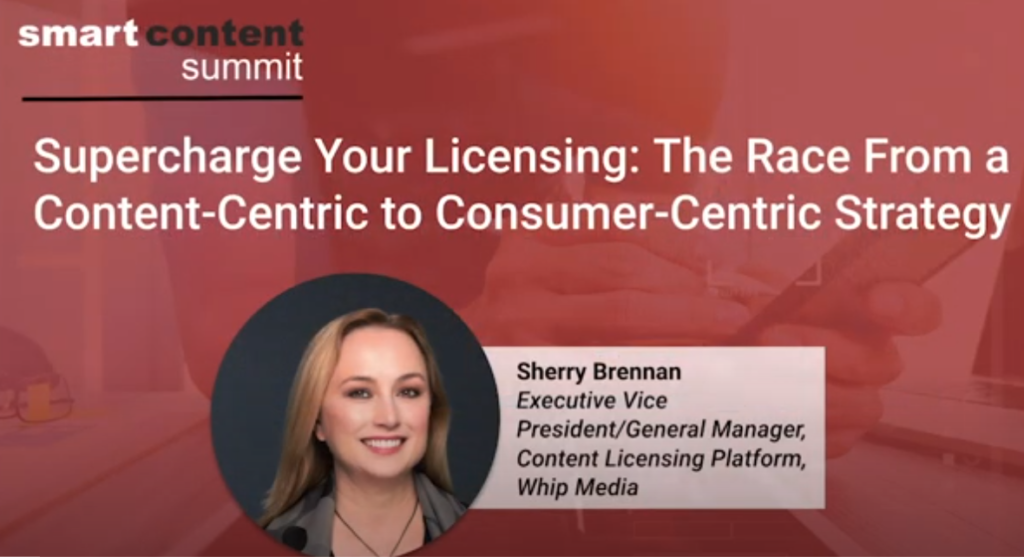Connections

Whip Media Exec: M&E Licensing Needs to Shift to a Consumer-Centric Strategy
Story Highlights
To remain competitive in today’s market, media and entertainment companies need a flexible, data-fed, insights-driven licensing solution that links consumer behaviour with content licensing, according to Sherry Brennan, EVP and GM of content licensing for Whip Media Group.
Whip Media has built a “very powerful prediction model… that we think is going to really change how people approach content licensing,” she said during the Consumers & Analytics breakout session “Supercharge Your Licensing: The Race From a Content-Centric to Consumer-Centric Strategy” at the March 16 Smart Content Summit event.
The executive noted that she had worked with data sets at the Federal Reserve Bank of San Francisco after graduate school before moving on to the cable TV industry, Fox and recently to Whip Media.
“I never thought I’d use that in my TV career but here I am,” she said with a laugh of her time with the Federal Reserve Bank of San Francisco, pointing out she has a background in streaming as a buyer and seller of content, along with big data and modelling.
Direct-to-consumer and over-the-top (OTT) streaming “has changed everything,” she said. “It’s changed everything for consumers and it’s changed everything for content owners and for the people who want to acquire content.”
Licensing used to be much simpler. Cable TV made TV more complicated. Then along came digital and more networks, video on demand, DVD and other technology that complicated it further, Brennan said.
 “But streaming has really been the formative technology that has really exploded the opportunities for consumers and for content owners and buyers because there are now multiple screens, overlapping windows, multiple business models,” she explained, adding: “There’s AVOD, SVOD, TVOD, PVOD. You can hardly keep up with all the VODs and now we have FAST [free ad-supported streaming TV] channels and let’s not forget about linear which still generates the lion’s share of revenue in the business,” she said with a laugh.
“But streaming has really been the formative technology that has really exploded the opportunities for consumers and for content owners and buyers because there are now multiple screens, overlapping windows, multiple business models,” she explained, adding: “There’s AVOD, SVOD, TVOD, PVOD. You can hardly keep up with all the VODs and now we have FAST [free ad-supported streaming TV] channels and let’s not forget about linear which still generates the lion’s share of revenue in the business,” she said with a laugh.
So there are “all kinds of different ways people can watch content, which has made it more complicated for the people who want to buy it or sell it to figure out how they can best interact with each other, and that is where information comes in handy,” she said.
Critical content decisions need to be directly connected to the consumer, according to the company.
“It’s pretty clear that companies in this space need to have… granular data” to help achieve that, and “they also need to have really great content to share with consumers and they need to make it relevant and personal to consumers, both on the recommendation side and also on the advertising side,” Brennan explained.
She pointed to a quote from Deloitte, saying: “When a consumer gets a relevant recommendation they get value from the interaction, and are more likely to stick around.”
Brennan also pointed to data from a survey of M&E businesses by Ernst & Young (EY) that found 62% of them saw data offering an opportunity.
But she said: “Not all data is created equal and just having data doesn’t really help you if you can’t do anything with it, if you can’t model it, if you can’t make stories out of it, if you can’t understand what it is telling you and get insights from that data it’s kind of worse to have it than not if it’s just sitting there.”
Whip Media believes that “the consumer needs to be at the heart of all licensing decisions and really can now that we have access to such great data,” she said.
Whip Media’s TV Time app “brings order to the chaos,” according to the company. The app now has about 16 million users and about 1 million people a day are using it to track what they watch and find where things are that they want to watch, according to Brennan.
The app notifies users when content they want to watch becomes available and helps them discover new content, she noted, adding that helps motivate them to keep providing info.
The data helps explain “the why behind the watch,” Brennan noted, adding Whip Media was able to use the data to predict how popular the Disney Plus TV show WandaVision would be.
The company is able to build a model that “links actual consumer behaviour with consumer sentiment and consumer reporting on what they’ve done so we can see what people like,” she said, adding: “We can build… affinity models through TV Time data and then we can model [and] we can train that model with our outcomes data to build these predictions of what people are going to do.”
Combining engagement insights with customer/viewer content affinity yields a Demand Score that enables the prediction of title performance, according to Whip Media. The technology, which uses machine learning, can even predict how content will do on each platform in each territory, Brennan noted.
“We are really excited about the future and what it all means,” she went on to say, showing just how granular the data can be and that it can predict how a show will perform vs. other content.
When viewers indicate they are bored, confused and frustrated, those shows tend to have worse engagement and completion rates, she noted.
Whip Media’s model performs better than other systems and the results speak for themselves, according to the company.
“We think the future for licensing is really bright and we’re very excited to bring” this solution to the licensing “ecosystem in probably fall of this year,” Brennan said. The company, meanwhile, is “listening with open ears” to suggestions from the industry, she concluded.
Click here to view the entire presentation.
The Smart Content Summit was produced by MESA and the Smart Content Council, and was sponsored by Microsoft Azure, Whip Media Group, Richey May Technology Solutions, BeBanjo, Digital Nirvana, Softtek, 24Notion, EIDR, The Quorum and Signiant.









